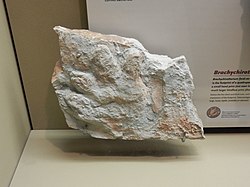Biology:Brachychirotherium
| Brachychirotherium | |
|---|---|

| |
| Brachychirotherium sp. from the Redonda Formation of New Mexico (New Mexico Museum of Natural History and Science) | |
| Trace fossil classification|Trace fossil classification | |
| Missing taxonomy template (fix): | Archosauria/Reptilia |
| Clade: | Pseudosuchia |
| Ichnofamily: | †Chirotheriidae |
| Ichnogenus: | †Brachychirotherium Beurlen, 1950 |
| Ichnospecies | |
|
See text | |
Brachychirotherium is an ichnogenus, a form taxon based on footprints. It is a type of chirothere ('hand beast'), a term referring to the footprints of five-toed Triassic reptiles with a short fifth digit, leaving an appearance similar to a reverse human hand print. Brachychirotherium was first characterized from fossils found in Triassic beds in Germany,[1] but has since been found in France,[2] South Africa,[3] Argentina , Peru,[4] Bolivia,[5][6] and North America.[7]
Description
Front (manus) and rear (pes) footprints are distinguishable, though manus prints are not always preserved. The pes prints show five toes, which are proportionally shorter and stubbier than those of other chirotheres. Digit III is the longest, followed by digits II and IV, though they are all of a similar length. Digit I is notably shorter, and the impression of digit V is reduced to an oval pad at the sole. The manus prints likewise show up to five short digits, with the pad of digit V separate from the rest. The surfaces of the sole and palm are broad, and creases are indistinct. The prints were likely produced by some form of large pseudosuchian (reptiles related to crocodilians), such as aetosaurs or quadrupedal rauisuchids.[8]
Species
[incomplete list]
- B. circaparvum Willruth, 1971
- B. eyermani Baird, 1957
- B. gallicum (Willruth, 1917)
- B. hassfurtenese Beurlen, 1950 (type species)
- B. lorteci Willruth, 1971
- B. thuringiacum (Ruhle von Lilienstern, 1938)
- B. tintati Willruth, 1971
See also
- List of dinosaur ichnogenera
References
- ↑ Beurlen, K. (1950). "Neue Fährtenfunde aus der Fränkischen Trias [New track discoveries in the Franconian Triassic].". Neues Jahrbuch für Geologie und Paläontologie - Monatshefte 1950: 308–320.
- ↑ Gand, G.; Demathieu, G.; Montenat, C. (2007). "Les traces de pas d'amphibiens, de dinosaures et autres reptiles du Mesozoïque français: Inventaire et interpretations [Footprints of amphibians, dinosaurs, and other reptiles from the French Mesozoic: inventory and interpretations"]. Palaeovertebrata 2007 (1–4): 1–149. https://d1wqtxts1xzle7.cloudfront.net/48334641/2015_Gand_8-with-cover-page-v2.pdf?Expires=1637779474&Signature=fwoWyd0ThEoCP4OEjkzLPvBsKRkicCGL7shbA9mywQb~vmLF-6INAIArmeJVU9HuyKilHxolguVjLkduF~90AIs2McXiw~7t8HvH6aP8EOJfDKMS24Pu6Oa225nZXPQivE18VViW6JX8pngJAoCGkK3paFl6lcy5bQjRGhwNkG1a3ok4~B8R~ZJfiEPN~Be~Mr8mzCOlQJ4uoWf0gbOGaUW9xG0qnmL5iIYTduFCyw-ZYonVHU72yoqyd0o~Qh6Jo6C7bs7CARowQqw6kV5tIR-Fti68jE9GR7JcVrEr5BYfbZO2hbZDZT0yFQDl1GBtDtQA9AdXLKb147AnFT3aGQ__&Key-Pair-Id=APKAJLOHF5GGSLRBV4ZA. Retrieved 24 November 2021.
- ↑ Olsen, P.E.; Galton, P.M. (1984). "A review of the reptile and amphibian assemblages from the Stormberg of southern Africa, with special emphasis on the footprints and the age of the Stormberg". Palaeontologia Africana 25: 87–110. https://www.researchgate.net/publication/237231345. Retrieved 24 November 2021.
- ↑ Salas Gismondi, Rodolfo; Chacaltana Budiel, César Augusto (2010). "Huellas de un arcosaurio triásico en la Formación Sarayaquillo (Cuenca Ene, Perú) y el icnoregistro de vertebrados en el mesozoico del Perú". Repositorio Institucional INGEMMET. https://repositorio.ingemmet.gob.pe/handle/20.500.12544/3696.
- ↑ Apesteguía, Sebastián; Riguetti, Facundo; Citton, Paolo; Veiga, Gonzalo D.; Poiré, Daniel G.; de Valais, Silvina; Gabriel Zacarías, Gerardo (2021-11-02). "The Ruditayoj-Tunasniyoj fossil area (Chuquisaca, Bolivia): a Triassic chirotheriid megatracksite and reinterpretation of purported thyreophoran tracks". Historical Biology 33 (11): 2883–2896. doi:10.1080/08912963.2020.1833328. ISSN 0891-2963. Bibcode: 2021HBio...33.2883A. https://doi.org/10.1080/08912963.2020.1833328.
- ↑ Leonardi, G. (1994). Annotated Atlas of South America in Argentina, Peru and Bolivia. Tetrapod Footprints (Devonian to Holocene) with an Appendix on Mexico and Central America. Brasília: República Federativa do Brasil, Ministério de Minas e Energia, Secretaria de Minas e Metalurgia, Companhia de Pesquisa de Recursos Minerais. pp. 1–248.
- ↑ Conrad, Kelly; Lockley, Martin G.; Prince, Nancy K. (1987). "Triassic and Jurassic vertebrate-dominated trace fossil assemblages of the Cimarron Valley region--Implications for paleoecology and biostratigraphy". New Mexico Geological Society Field Conference Series 38: 127–138. https://nmgs.nmt.edu/publications/guidebooks/downloads/38/38_p0127_p0138.pdf. Retrieved 1 September 2020.
- ↑ Hunt, Adrian P.; Lucas, Spencer G.; Klein, Hendrik (2018), Tanner, Lawrence H., ed., "Late Triassic Nonmarine Vertebrate and Invertebrate Trace Fossils and the Pattern of the Phanerozoic Record of Vertebrate Trace Fossils" (in en), The Late Triassic World: Earth in a Time of Transition, Topics in Geobiology (Cham: Springer International Publishing): pp. 447–544, doi:10.1007/978-3-319-68009-5_12, ISBN 978-3-319-68009-5, https://doi.org/10.1007/978-3-319-68009-5_12, retrieved 2023-07-19
Wikidata ☰ Q109974353 entry
 |

